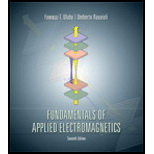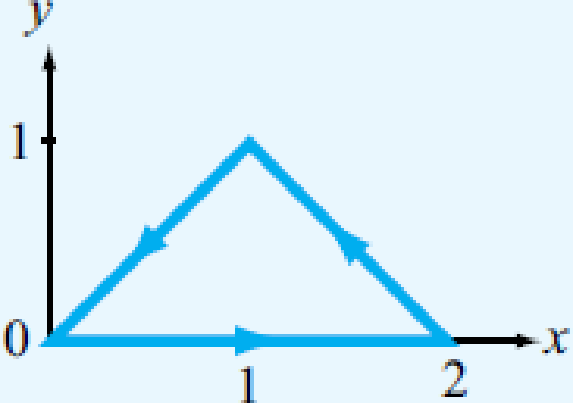
Fundamentals of Applied Electromagnetics (7th Edition)
7th Edition
ISBN: 9780133356816
Author: Fawwaz T. Ulaby, Umberto Ravaioli
Publisher: PEARSON
expand_more
expand_more
format_list_bulleted
Concept explainers
Textbook Question
Chapter 3, Problem 51P
Repeat Problem 3.50 for the contour shown in Fig. P3.50(b).

Expert Solution & Answer
Want to see the full answer?
Check out a sample textbook solution
Students have asked these similar questions
Waveforms v1(t) and v2(t) are given by:v1(t) = −4 sin(6π ×10^4t +30◦) V,v2(t) = 2cos(6π ×10^4t −30◦) V.Does v2(t) lead or lag v1(t), and by what phase angle?
7.1 Express the current waveform
i(t) = -0.2 cos(6 × 10°1 +60°) mA
in standard cosine form and then determine the following:
(a) Its amplitude, frequency, and phase angle.
(b) i(t) at t=0.1 ns.
3. Consider the RC circuit with a constant voltage source shown in the diagram below. The
values of the resistor, capacitor, and input voltage are R = 50, C = 10 µF, and V = 6V,
respectively. Assume that there is initially no charge on the capacitor before the switch is
closed.
Vo
↑i(t)
R
w
C
When the switch closes at time t = 0, the current begins to flow as a function of time according
to the equation
i(t) = ioenc
Chapter 3 Solutions
Fundamentals of Applied Electromagnetics (7th Edition)
Ch. 3.1 - When are two vectors equal and when are they...Ch. 3.1 - Prob. 2CQCh. 3.1 - If AB = 0, what is AB?Ch. 3.1 - If AB = 0, what is AB?Ch. 3.1 - Is A(BC) a vector triple product?Ch. 3.1 - If AB = AC, does it follow that B = C?Ch. 3.1 - Find the distance vector between P1 = (1, 2, 3)...Ch. 3.1 - Find the angle AB between vectors A and B of...Ch. 3.1 - Prob. 3ECh. 3.1 - Vectors A and B lie in the y-z plane and both have...
Ch. 3.1 - If AB=AC, does it follow that B = C?Ch. 3.2 - A circular cylinder of radius r = 5 cm is...Ch. 3.3 - Why do we use more than one coordinate system?Ch. 3.3 - Prob. 8CQCh. 3.3 - Prob. 9CQCh. 3.3 - How is the position vector of a point in...Ch. 3.3 - Prob. 7ECh. 3.3 - Prob. 8ECh. 3.4 - Prob. 9ECh. 3.4 - Find the directional derivative of V=rz2cos2 along...Ch. 3.4 - Prob. 11ECh. 3.4 - Prob. 12ECh. 3.5 - Given A=e2y(xsin2x+ycos2x), find A.Ch. 3.5 - Given A=rrcos+rsin+z3z , find A at (2,0, 3).Ch. 3.5 - If E=RAR in spherical coordinates, calculate the...Ch. 3.5 - Verify the divergence theorem by calculating the...Ch. 3.5 - Prob. 17ECh. 3.6 - Find A at (2, 0, 3) in cylindrical coordinates for...Ch. 3.6 - Find A at (3, /6, 0) in spherical coordinates for...Ch. 3.7 - What do the magnitude and direction of the...Ch. 3.7 - Prob. 12CQCh. 3.7 - Prob. 13CQCh. 3.7 - Prob. 14CQCh. 3.7 - What is the meaning of the transformation provided...Ch. 3.7 - Prob. 16CQCh. 3.7 - Prob. 17CQCh. 3.7 - When is a vector field conservative?Ch. 3 - Prob. 1PCh. 3 - Given vectors A=x2y3+z, B=x2y+z3, and C=x4+y2+z2,...Ch. 3 - Prob. 3PCh. 3 - Prob. 4PCh. 3 - Given vectors A=x+y2z3, B=x2y4, and C=y2z4, find...Ch. 3 - Given vectors A=x2y+z3 and B=x3z2, find a vector C...Ch. 3 - Given A=x(x+2y)y(y+3z)+z(3xy), determine a unit...Ch. 3 - By expansion in Cartesian coordinates, prove: (a)...Ch. 3 - Find an expression for the unit vector directed...Ch. 3 - Prob. 10PCh. 3 - Prob. 11PCh. 3 - Prob. 12PCh. 3 - A given line is described by x+2y=4. Vector A...Ch. 3 - Prob. 14PCh. 3 - Prob. 15PCh. 3 - Given B=x(z3y)+y(2x3z)z(x+y), find a unit vector...Ch. 3 - Find a vector G whose magnitude is 4 and whose...Ch. 3 - A given line is described by the equation: y=x1....Ch. 3 - Vector field E is given by E=R5Rcos12Rsincos+3sin....Ch. 3 - Prob. 20PCh. 3 - Prob. 21PCh. 3 - Prob. 22PCh. 3 - Prob. 23PCh. 3 - Prob. 24PCh. 3 - Use the appropriate expression for the...Ch. 3 - Prob. 26PCh. 3 - A section of a sphere is described by 0 R 2, 0 ...Ch. 3 - A vector field is given in cylindrical coordinates...Ch. 3 - At a given point in space, vectors A and B are...Ch. 3 - Given vectors...Ch. 3 - Prob. 31PCh. 3 - Prob. 32PCh. 3 - Transform the vector A=Rsin2cos+cos2sin into...Ch. 3 - Transform the following vectors into cylindrical...Ch. 3 - Transform the following vectors into spherical...Ch. 3 - Find the gradient of the following scalar...Ch. 3 - For each of the following scalar fields, obtain an...Ch. 3 - The gradient of a scalar function T is given by...Ch. 3 - Prob. 39PCh. 3 - For the scalar function V = xy2 z2, determine its...Ch. 3 - Evaluate the line integral of E=xxyy along the...Ch. 3 - Prob. 42PCh. 3 - Prob. 43PCh. 3 - Each of the following vector fields is displayed...Ch. 3 - Prob. 45PCh. 3 - For the vector field E=xxzyyz2zxy, verify the...Ch. 3 - For the vector field E=r10erz3z, verify the...Ch. 3 - A vector field D=rr3 exists in the region between...Ch. 3 - For the vector field D=R3R2, evaluate both sides...Ch. 3 - For the vector field E=xxyy(x2+2y2), calculate (a)...Ch. 3 - Repeat Problem 3.50 for the contour shown in Fig....Ch. 3 - Verify Stokess theorem for the vector field...Ch. 3 - Prob. 53PCh. 3 - Prob. 54PCh. 3 - Verify Stokess theorem for the vector field B = (r...Ch. 3 - Prob. 56PCh. 3 - Prob. 57PCh. 3 - Find the Laplacian of the following scalar...
Knowledge Booster
Learn more about
Need a deep-dive on the concept behind this application? Look no further. Learn more about this topic, electrical-engineering and related others by exploring similar questions and additional content below.Similar questions
- Q2. a) A three-phase 415 V, 4-pole, 50 Hz, A-connected induction motor was tested. The obtained results are: (i) (ii) No load test 50 Hz: Blocked rotor test, 10 Hz: DC test: Vnl=415 V, Pnl=1200 W, In=11 A Vbr 10 V, Pbr=1500 W, Ibr=91 A VDC 3 V, IDC=107 A Draw the per-phase equivalent electrical circuit of the motor Draw the circuits for no-load and block-rotor tests and indicate the slip for each of the tests. (iii) Identify the motor parameters (iv) Calculate the motor's starting torque at the rated voltage.arrow_forward4. Consider the RC circuit with a sinusoid voltage source shown in the diagram below. The values of the resistor, capacitor, input voltage amplitude and frequency are R-20012, C-5pF", Vo-10V, and w=500 rad/s, respectively. Assume that the circuit has reached steady state. Vрейте 2 The input voltage can be described using the complex sinusoid function V(t)-Vo and the physical voltage is obtained by taking the real part of V(t). The voltage drop across the capacitor is given by a sinusoid with same the frequency was the input voltage, but a different magnitude and different phase. In complex form, the capacitor's voltage is given by Vc(t)=1+jwRC For the following questions, use the template file Assignment TemplateQ2.m as the starting point for your MATLAB code. (a) (6 marks) Use MATLAB to make a graph that shows the real part of the input voltage source ReV(t)] and the real part of the voltage drop across the capacitor Re[Ve(t)] as a function of time. Choose the time scale so that two…arrow_forwardConsider the microgrid given in figure 8-56. The positive sequence impedance of the transmission Lines is given in -line diagram (figure 8.5%). The system data are as follows: the one PV generating Station: 2MW, 460V. AC, positive, negative and zero Sequence impedance of each line is equal to 10%. The generator negativ Sequence impedance is equal to the positive Sequence, and the Zero Sequence impedance is equal to half (½) of positiv Sequence impedance. Transformers positive sequence impedance is equal to the negative sequence and equal to the zero sequence impedance Station DC/AC CB Acpu bus CB www S+js 5 1+jlo M 2 T2 SB CB A Jus -3+16 local utilityarrow_forward
- a) The current drawn by a single-phase converter is represented by the waveform in the figure below. Use Fourier series analysis to determine an expression for obtaining the rms values of the fundamental and the harmonics of the source current. Hence, express the rms value of the fundamental as well as the first three harmonics of the waveform. i(t) Id - Id π 元 b) Fig. Input current waveform of a single phase bridge rectifier A sinusoidal voltage with a peak value of 300 V is applied to the converter in (a) drawing a square-wave current with a peak value of 15 A. Assuming that the zero crossing of the current waveform is 45° behind that of the input voltage waveform, calculate: (i) the average power drawn by the converter, (ii) the form factor (FF) and ripple factor (RF) (iii) the total harmonic distortion (THD%) of the input current.arrow_forwardTransformer 600 V Transformer L₁ L₂ L3 4 (a) 600 V L₁ L₂ L3 L₁ (b) Figure 3.arrow_forward(2 marks) Using Kirchoff's voltage law: V(t) = VR(t) + Vc(t), show that the voltage drop across the resistor is given by the equation VR(t) jwRC 1+jwRC Voearrow_forward
- A ferrite ETD44 core type material is to be used in the converter design. If Bmax = 0.52T, and 350 turns of 1.5x10³cm² copper wire is to be wound around the core material to allow a flow of 5A maximum current, compute for the (a) inductor resistance, and the (b) inductance.arrow_forwardDon't use ai to answer I will report you answerarrow_forwardPlease show the solution and answers each. Thank you.arrow_forward
- A lossless resonant half-wavelength dipole antenna, with input impedance of 73 ohms, is connected to a transmission line whose characteristic impedance is 50 ohms. Assuming that the normalized pattern 000300 30° 90° 1 cos() of the antenna is given approximately by U(0) = 0.866 0 30° <0≤90° Find the maximum absolute gain of this antenna.arrow_forwardPlease show the solution and answers in each. Thank you.arrow_forwardPlease show how to solve this.arrow_forward
arrow_back_ios
SEE MORE QUESTIONS
arrow_forward_ios
Recommended textbooks for you
 Introductory Circuit Analysis (13th Edition)Electrical EngineeringISBN:9780133923605Author:Robert L. BoylestadPublisher:PEARSON
Introductory Circuit Analysis (13th Edition)Electrical EngineeringISBN:9780133923605Author:Robert L. BoylestadPublisher:PEARSON Delmar's Standard Textbook Of ElectricityElectrical EngineeringISBN:9781337900348Author:Stephen L. HermanPublisher:Cengage Learning
Delmar's Standard Textbook Of ElectricityElectrical EngineeringISBN:9781337900348Author:Stephen L. HermanPublisher:Cengage Learning Programmable Logic ControllersElectrical EngineeringISBN:9780073373843Author:Frank D. PetruzellaPublisher:McGraw-Hill Education
Programmable Logic ControllersElectrical EngineeringISBN:9780073373843Author:Frank D. PetruzellaPublisher:McGraw-Hill Education Fundamentals of Electric CircuitsElectrical EngineeringISBN:9780078028229Author:Charles K Alexander, Matthew SadikuPublisher:McGraw-Hill Education
Fundamentals of Electric CircuitsElectrical EngineeringISBN:9780078028229Author:Charles K Alexander, Matthew SadikuPublisher:McGraw-Hill Education Electric Circuits. (11th Edition)Electrical EngineeringISBN:9780134746968Author:James W. Nilsson, Susan RiedelPublisher:PEARSON
Electric Circuits. (11th Edition)Electrical EngineeringISBN:9780134746968Author:James W. Nilsson, Susan RiedelPublisher:PEARSON Engineering ElectromagneticsElectrical EngineeringISBN:9780078028151Author:Hayt, William H. (william Hart), Jr, BUCK, John A.Publisher:Mcgraw-hill Education,
Engineering ElectromagneticsElectrical EngineeringISBN:9780078028151Author:Hayt, William H. (william Hart), Jr, BUCK, John A.Publisher:Mcgraw-hill Education,

Introductory Circuit Analysis (13th Edition)
Electrical Engineering
ISBN:9780133923605
Author:Robert L. Boylestad
Publisher:PEARSON

Delmar's Standard Textbook Of Electricity
Electrical Engineering
ISBN:9781337900348
Author:Stephen L. Herman
Publisher:Cengage Learning

Programmable Logic Controllers
Electrical Engineering
ISBN:9780073373843
Author:Frank D. Petruzella
Publisher:McGraw-Hill Education

Fundamentals of Electric Circuits
Electrical Engineering
ISBN:9780078028229
Author:Charles K Alexander, Matthew Sadiku
Publisher:McGraw-Hill Education

Electric Circuits. (11th Edition)
Electrical Engineering
ISBN:9780134746968
Author:James W. Nilsson, Susan Riedel
Publisher:PEARSON

Engineering Electromagnetics
Electrical Engineering
ISBN:9780078028151
Author:Hayt, William H. (william Hart), Jr, BUCK, John A.
Publisher:Mcgraw-hill Education,
Electric Charge and Electric Fields; Author: Professor Dave Explains;https://www.youtube.com/watch?v=VFbyDCG_j18;License: Standard Youtube License